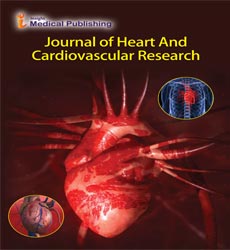ISSN : ISSN: 2576-1455
Journal of Heart and Cardiovascular Research
Early Neurodevelopment among Kids with Inherent Heart Disease
Michel Khan*
Department of Cardiovascular Epidemiology, Weizmann Institute of Science, Rehovot, Israel
- *Corresponding Author:
- Michel khan
Department of Cardiovascular Epidemiology,
Weizmann Institute o f Science, Rehovot,
Israel,
E-mail: khan@gmail.com
Received date: November 10, 2023, Manuscript No. IPJHCR-24-18467; Editor assigned date: November 13, 2023, PreQC No. IPJHCR-24-18467 (PQ); Reviewed date: November 27, 2023, QC No. IPJHCR-24-18467; Revised date: December 04, 2023, Manuscript No. IPJHCR-24-18467 (R); Published date: December 11, 2023, DOI: 10.36648/2576-1455.7.03.48
Citation: Khan M (2023) Early Neurodevelopment among Kids with Inherent Heart Disease. J Heart Cardiovasc Res Vol.7 No.3:48.
Introduction
Congenital Heart Disease (CHD) addresses the most incessant innate contortion. CHD patients might show mental, language, and engine formative deferral during outset and youth. These issues might continue until young and youthfulness, affectiing instructive accomplishment and grown-up result. Preoperatively, cerebrum injury, like White Matter Injury (WMI), hemorrhagic injury, and stroke, is obvious in 39% of children with complex CHD and may increment to 56% postoperatively, specifically among those with univentricular CHD. In the CHD populace, existing examinations are problematic with respect to the relationship between perioperative mind wounds and ensuing neurodevelopmental result. A few investigations have tracked down a relationship of neonatal cerebrum injury with neonatal neurological irregularities, lower mental execution at 1 year old enough, more terrible mental and engine improvement at 2 years old, and less fortunate comprehension at 6 years old. Conversely, one more enormous review tracked down no relationship between cerebrum injury and 2-year result. Expected explanations behind the conflicting relationship between cerebrum injury and result is an absence of normal meaning of the seriousness of mind wounds as well as a to a great extent shifting predominance of mind injury between various focuses because of strategic contrasts around incorporation models, careful and perioperative administration, and X-ray conventions.
Cardiovascular Medical Procedure
The point of our review was to explore the connection between perioperative generally speaking cerebrum injury load and formative result at 12 to 30 months old enough in a pooled companion of CHD patients from European habitats, who required cardiopulmonary detour a medical procedure in the initial a month and a half after birth. To gauge the general mind injury load, we assessed preoperative and postoperative imaging as per our recently distributed normalized depiction of cerebrum injuries and we made a general mind injury score thinking about type and area of preoperative and postoperative mind wounds. We guessed that a higher generally speaking cerebrum injury score was related with more terrible neurodevelopmental result inside the initial two years . Three forthcoming observational partner studies were joined inside European Affiliation Cerebrum in Intrinsic Coronary Diseases (EACICD) consortium as depicted exhaustively in past reports. CHD remembered for the review were interpretation of the extraordinary supply routes, Single Ventricle Physiology (SVP) characterized as hypoplastic left heart complex and hypoplastic right heart complex, and left ventricular outpouring lot and additionally aortic curve deterrent, which was characterized as left ventricular surge parcel as well as aortic curve hindrance like aortic valve stenosis, or aortic curve coarctation, hypoplasia, or interference. Kids with known or thought hereditary or syndromic messes were rejected. Clinical qualities were gathered tentatively at each middle. The individual institutional moral examination boards endorsed the investigations. Parental informed assent was gotten for the utilization of clinically acquired information for research purposes or before concentrate on enlistment.
Aortic Curve Deterrent
The aortic arch is the section of the aorta between the ascending and descending aorta. As it arises from the ascending aorta, the arch runs slightly backward and to the left of the trachea. The distal segment of the aortic arch then traverses downwards at the fourth thoracic vertebra. Investigations were performed utilizing Neurodevelopmental result was contrasted and the standardizing mean utilizing one-example t-tests and Mann-Whitney U tests relying upon appropriation of information. For the essential examination question, a numerous straight relapse investigation was utilized, controlling for CHD subgroup, length of clinic stay, SES; age at follow-up, and focus. Number of medical procedures until follow-up was profoundly related with (Line of Sight) LOS and in this way just LOS was remembered for additional examinations. There could have been no other huge collinearities. LOS was log-changed because of slanted information circulation. Direct relapse models were utilized to correspond the dichotomized generally mind injury score with result. Utilizing strategic relapse models, relationship between the dichotomized result and injury scores were assessed. This multitude of models was adapted to similar factors as referenced previously.
Open Access Journals
- Aquaculture & Veterinary Science
- Chemistry & Chemical Sciences
- Clinical Sciences
- Engineering
- General Science
- Genetics & Molecular Biology
- Health Care & Nursing
- Immunology & Microbiology
- Materials Science
- Mathematics & Physics
- Medical Sciences
- Neurology & Psychiatry
- Oncology & Cancer Science
- Pharmaceutical Sciences
